| |
Constantine's
6 Major Changes to Christianity |
|
This
exposé is under construction |
|
Click
on images to enlarge |
Technological
change that advances the human race is GREAT . . . but changing and
falsify historical events is just plain lying.
| 1. |
Constantine
changed the place of the Resurrection of Christ. |
| 2. |
Constantine
changed the time of the Resurrection of Christ. |
| 3. |
Constantine
changed the time of the birth of Christ. |
| 4. |
Constantine
changed the Scriptural method of becoming a Christian.
|
| 5. |
Constantine
changed the relationship of Christianity to the state. |
| 6. |
Constantine
changed the headquarters from Jerusalem to Rome and Constantinople. |
Pope Constantine changed
the PLACE of the Resurrection of Christ!!
Constantine
knew from experience that the great power of the Christian message came
from the preaching of the Resurrection of Christ. Immediately upon assuming
the purple, he set about to insidiously undermine and then eliminate
this cardinal doctrine.
For
300 years, the Christians were accustomed to visit the empty tomb on
the Mount of Olives in Jerusalem, and they came back home filled with
zeal for their Risen Lord.
They
also saw the total ruins of the Temple in exact fulfillment of the words
of Jesus. This made them invincible to all the threats and arguments
of the pagans. Constantine set about to change this:
"Believers
in Jesus all congregate from all parts of the world....that they may
worship at the MOUNT OF OLIVES opposite the city....TO THE CAVE that
is shown there" (Eusebius,
Proof of the Gospel, Bk. VI. ch. 18).
The
Empty Tomb on the Mount of Olives
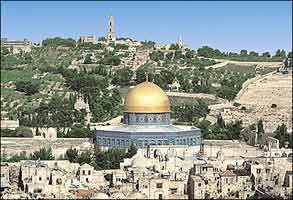
Mount
of Olives overlooking Jerusalem.
|
The
Mount of Olives on the eastern side of Jerusalem was the site
of the death and Resurrection of Christ in 30 A.D. |
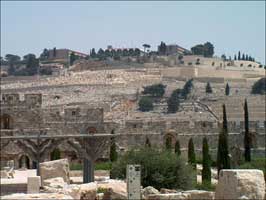
Mount
of Olives. |
The
Resurrection of Christ is the great central Doctrine of Christianity.
It is the ROCK and pillar that supports the entire structure. St. Paul
said:
"And
if Christ be not risen, then is our preaching vain, and your faith
is also vain"
(I Cor. 15:14).
And
again:
"But
now is Christ risen from the dead, and become the firstfruits of them
that slept. For since by man came death, by man also came the resurrection
of the dead, For as in Adam all die, even so in Christ shall all be
made alive" (I Cor. 15:20-22).
In
the year 326, Constantine sent his mother Helena to Jerusalem to discover
the spot that he had foreseen as the place of Jesus' Resurrection.
This was the site of the temple of Venus on the western side of Jerusalem.
He ordered the temple torn down and a church constructed on the site.
This is called the church of the "Holy" Sepulchre to this
day.
"Church"
of the Holy Sepulchre, former site of the Temple of Venus.
Christian
historian Eusebius said that the "Holy" Sepulchre was built
on the site of the Temple of Venus.
When
the Romans finally conquered Jerusalem in 135 A.D., as an insult to
the Jews, they built a Temple of Venus over a monument to a Jewish freedom
fighter named John Hyrcanus.
This
"gloomy shrine of lifeless idols" was the site which Constantine
later chose to built his Church of the "Holy" Sepulchre:
"This
sacred cave, then, certain impious and godless persons had though
to remove entirely from the eyes of men, supposing in their folly
that thus they should be able effectually to obscure the truth. Accordingly
they brought a quantity of earth from a distance with much labor,
and covered the entire spot; then, having raised this to a moderate
height, they paved it with stone, concealing the holy cave beneath
this massive mound. Then, as though their purpose
had been effectually accomplished, they prepare on this foundation
a truly dreadful sepulchre of souls, by building a gloomy shrine of
lifeless idols to the impure spirit whom they call Venus, and offering
detestable oblations therein on profane and accursed altars.
For they supposed that their object could not otherwise be fully attained,
than by thus burying the sacred cave beneath these foul pollutions."
(Life of Constantine, chapter 26).
| 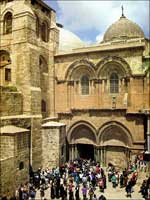
Church
of the Holy Sepulchre, former site of the Temple of Venus. |
Emperor
Constantine's mother Helena discovered this site after finding
3 crosses that had not rotted after 3 hundred years!!
If Constantine
said the site was at the North Pole it would have been accepted
because nobody questioned the Emperor.
Both Latins
and Orthodox share this site.
|
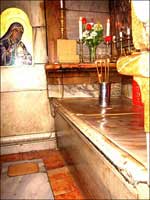
The
so-called tomb of Jesus. |
This
is the WRONG location because it was located within the city of Jerusalem
and Jesus died outside the city walls.
While
not even a baptized Christian, Constantine was relying on his dreams
and vision to locate the holy places. His biographer, Eusebius of
Caesarea, dared not question Constantine about the veracity of his
visions, because that would mean the destruction of all his writings,
and his banishment or even death:
"You will,
it may be, also detail to us those particulars of his favor which
are secret to us, but known to you alone and treasured in your royal
memory as in secret storehouses. Such, doubtless, are the reasons,
and such the convincing proofs of your Saviour's power, which caused
you to raise that sacred edifice which presents to all, believers
and unbelievers alike, a trophy of his victory over death, a holy
temple of the holy God: to consecrate those noble and splendid monuments
of immortal life and his heavenly kingdom: to offer memorials of our
Almighty Saviour's conquest which well become the imperial dignity
of him by whom they are bestowed. With such memorials have you adorned
that edifice which witnesses of eternal life: thus, as it were in
imperial characters, ascribing victory and triumph to the heavenly
Word of God: thus proclaiming to all nations, with clear and unmistakable
voice, in deed and word, your own devout and pious confession of his
name." (The Oration of Eusebius, chapter
18).
Never once in the
Bible do we find the Lord ever flattering or lauding any person....The
writings of Eusebius about Constantine are filled with hyperbole or
veiled sarcasm, in order to hide the real character of the Emperor,
and thus save his writings for posterity.
Constantine changed the TIME of the Resurrection of the Lord!!
The
Christians remembered the Lord's Resurrection every Sabbath or Lord's
Day. In addition there was the big yearly week long celebration of the
Resurrection held 14 days after the first new moon following the spring
equinox. It always coincided with the yearly Jewish Passover.
This
year the anniversary of that
great event falls on April 9, 2009.
In
325, Constantine presided over the Council of Nicaea which changed the
time of the Lord's Resurrection to the first Sunday (or Lord's Day)
following the spring equinox.
JEHOVAH's new
year begins at the new moon following the spring equinox
Here
is the dictionary definition of the word EQUINOX:
"Either
of the two times during a year when the sun crosses the celestial
equator and when the length of day and night are approximately equal;
the vernal equinox or the autumnal equinox."
(Webster's Third New International Dictionary).
As
you can see from this correct definition, the idea that the earth
does the moving—and not the sun—is sheer LUNACY!!
The
feast of the Passover and Resurrection was celebrated every year by
the Christians on the 14th of the month following the new moon, following
the equinox....It was the most important holiday on their calendar.
Here is a quote from one of the Early Congregation Fathers named
Saint Anatolius of Laodicea:
"
. . .Following their example up to the present time all the bishops
of Asia—as themselves
also receiving the rule from an unimpeachable authority, to wit,
the evangelist John, who leant on the Lord's breast, and drank in
instructions spiritual without doubt —
were in the way of celebrating the Paschal
feast, without question, every year, whenever the fourteenth day
of the moon had come, and the lamb was sacrificed by the Jews after
the equinox was past."
(Saint Anatolius of Laodicea).
Constantine changed the TIME of our Saviour's birth to December 25
Besides
the Mount of Olives, another great destination for the Christian pilgrims
was the town of Bethlehem where Jesus was born in the springtime:
"They
(prophets) foretold the wondrous fashion of his birth from a Virgin,
and—strangest of all—they did not omit to name Bethlehem the place
of his birth, which is today so famous that men still hasten from
the ends of the earth to see it, but shouted it out with the greatest
clearness"
(Eusebius, The Proof of the Gospel, Bk. 1, p. 2).
The
Latins celebrate the birth of Jesus on December 25, while the Orthodox
follow the Julian calendar which is 13 days behind the Latin Gregorian.
| 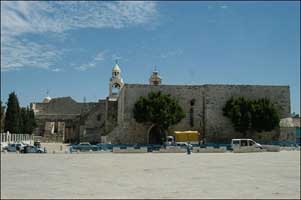
Church
of the Nativity where Jesus was born. |
The
Church of the Nativity in Bethlehem is the spot where Jesus is
supposed to be born.
It
is owned by the Orthodox who celebrate His birthday on Jan. 7.
Jesus
was born in the springtime so both churches have the wrong date.
|
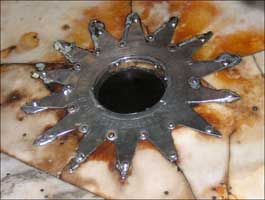
The
exact spot where Jesus was supposed to be born. |
The
first month of the Jewish year is the equivalent of our March/April.
6 months later would be equivalent to our August/September. According
to the Bible, Mary conceived in the 6th month:
"And
in the sixth month the angel Gabriel
was sent from God unto a city of Galilee, named Nazareth,To a virgin
espoused to a man whose name was Joseph, of the house of David; and
the virgin's name was Mary." (luke I:26-27).
Nine
months later would take us to April/May of the Jewish year and the correct
time for the birth of Jesus.
Lambing
season is also in the springtime when the shepherds would be outdoors
watching their sheep.
After
the winter solstice, the pagans saw the days getting longer, so they
rejoiced as the SUN was reborn,and they called this festival Dies
Natalis Invicti or The Birthday of the Unconquered SUN.
Constantine
changed the Scriptural method of becoming a Christian.
Prior
to the time of Constantine, a person became a Christian through conversion
or the new birth. Baptism followed salvation. Constantine
waited until just before his death to be baptized, because he believed
that baptism washed away sins and makes one a Christian:
"The
time is arrived which I have long hoped for, with an earnest desire
and prayer that I might obtain the salvation of God. The hour is come
in which I too may have the blessing of that seal which confers immortality.
I had thought to do this in the waters of the river Jordan, wherein
our Saviour, for our example, is recorded to have been baptized: but
God, who knows what is expedient for us, is pleased that I should
receive this blessing here. Be it so, then, without delay: for should
it be his will who is Lord of life and death, that my existence here
should be prolonged, and should I be destined henceforth to associate
with the people of God, and unite with them in prayer as a member
of his Church, I will prescribe to myself from this time such a course
of life as befits his service. After he had thus spoken, the prelates
performed the sacred ceremonies in the usual manner, and, having given
him the necessary instructions, made him a partaker of the mystic
ordinance. Thus was Constantine the first of all sovereigns who was
regenerated and perfected in a church dedicated to the martyrs of
Christ; thus gifted with the Divine seal of baptism, he rejoiced in
spirit, was renewed, and filled with heavenly light his soul was gladdened
by reason of the fervency of his faith, and astonished at the manifestation
of the power of God. At the conclusion of the ceremony he arrayed
himself in shining imperial vestments, brilliant as the light, and
reclined on a couch of the purest white, refusing to clothe himself
with the purple any more." (Eusebius, The
Life of Constantine, chapter 62).
To
this very day, all of his followers have used that same door:
"Holy
Baptism is the basis of the whole Christian life, the gateway to life
in the Spirit (vitae spiritualis ianua), and the door which gives
access to the other sacraments. Through Baptism we are freed from
sin and reborn as sons of God; we become members of Christ, are incorporated
into the Church and made sharers in her mission: "Baptism is the sacrament
of regeneration through water in the word."
(Catechism of the Catholic Church, 1997, Part Two, Article
1).
One
of the most infamous heresiarch that ever lived was Simon Magus or Simon
the Sorcerer. Simon was baptized by none other than one of the 12
apostles of Jesus:
"But
when they believed Philip preaching the things concerning the kingdom
of God, and the name of Jesus Christ, they were baptized, both men
and women.
Then Simon himself believed also: and when he was baptized,
he continued with Philip, and wondered, beholding the miracles and
signs which were done."(Acts 8 :12-13).
Constantine
believed like Simon and was baptized, but that did absolutely nothing
to change him inwardly.
Unlike
previous Roman Emperors, Constantine shunned pagan CREAMATION and was
BURIED in the city of Constantinople, in the Church of the Holy Apostles.
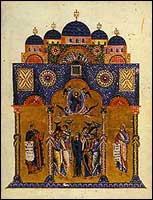
Depiction
of the Church of the Holy Apostles in an illuminated manuscript.
|
The
Turks completely destroyed the burial place of Emperor Constantine.
He
shunned Roman pagan cremation and was buried surrounded
by images of the 12 apostles. |
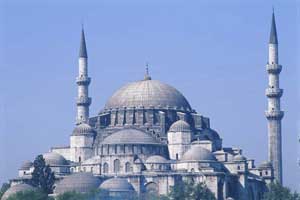
Conqueror's
Mosque (Fatih Camii), Istanbul, former site of the Church of the
Holy Apostles. |
Even
though he repudiated the pagan Roman gods and founded a rival capital
for the Empire, there was profound mourning for Constantine at Rome.
Obviously they did not believe that he went to a better place:
"On
the arrival of the news of the emperor's death in the imperial city,
the Roman senate and people felt the announcement as the heaviest
and most afflictive of all calamities, and gave themselves up to an
excess of grief. The baths and markets were closed, the public spectacles,
and all other recreations in which men of leisure are accustomed to
indulge, were interrupted. Those who had erewhile lived in luxurious
ease, now walked the streets in gloomy sadness, while all united in
blessing the name of the deceased, as the one who was dear to God,
and truly worthy of the imperial dignity. Nor was their sorrow expressed
only in words : they proceeded also to honor him, by the dedication
of paintings to his memory, with the same respect as before his death.
The design of these pictures embodied a representation of heaven itself,
and depicted the emperor reposing in an ethereal mansion above the
celestial vault. They too declared his sons alone to be emperors and
Augusti, and begged with earnest entreaty that they might be permitted
to receive the body of their emperor, and perform his obsequies in
the imperial city." (Life of Constantine,
chapter 69).
Pope
Constantine united Christianity and the state
Jesus
spelt out the relationship of Christianity to the state very clearly
when he said:
"And
he said unto them, Render therefore unto Caesar the things which be
Caesar's, and unto God the things which be God's." (Luke 20:25).
In
other words, the government was to take care of the material needs of
the people, and the kingdom of Christ the spiritual.
The
Western LEG of the Roman Empire completely ignored this plain teaching
of the Scriptures, and sought to unite Christianity and the state, with
the Popes completely dominating both.
Here
is a quote from the Syllabus of Errors
of Pope Pius IX:
"55. The Church
ought to be separated from the State, and the State from the Church.
—Allocution "Acerbissimum," Sept. 27, 1852."
(Condemned as error).
The
Eastern Emperors did not claim to take the place of God Almighty on
earth, and totally dominate the state as the Western Emperors or Popes.
Constantine
changed the headquarters from Jerusalem to Rome and Constantinople
For the 3 centuries
prior to Constantine, Christians traveled from the end of the earth
to Jerusalem, to view the empty tomb on the Mount of Olives:
"Believers
in Jesus all congregate from all parts of the world....that they may
worship at the MOUNT OF OLIVES opposite the city....TO THE CAVE that
is shown there" (Eusebius,
Proof of the Gospel, Bk. VI. ch. 18).
Constantine set
up 2 rival centers and Jerusalem was eventually relegated to a backwater.
In the Old Testament
Book of Kings, Jeroboam set up 2 golden calves: one at Dan in the north
and another at Bethel in the south in order to keep the people
from going to Jerusalem to worship:
"Whereupon
the king took council, and made two calves of gold, and said unto
them, It is too much for you to go up to Jerusalem: behold thy gods,
O Israel which brought thee up out of the land of Egypt. And he set
the one in Dan and the other in Bethel"
(I Kings 12:28-29)
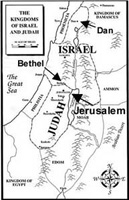
Dan and
Bethel became the 2 new rival centers to Jerusalem.
|
In
the Old Testament, Jeroboam created 2 rival centers to Jerusalam.
One
was located in Dan in the North, and the other was located in
Bethel in the South.
Both
became bitter rivals. |
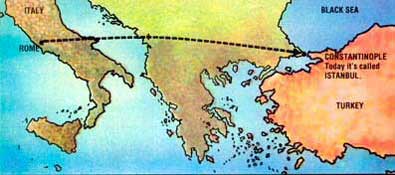
Rome
and Constantinople became the 2 new headquarters of this new Constantinian
"Christianity." |
References
Alföldi,
Andreas (Andrew). The Conversion of Constantine and Pagan Rome.
Oxford, 1948 and 1969.
Eusebius
Pamphili, (260 - 340), Preparation for the Gospel, Proof of
the Gospel, Ecclesiastical History, Life of Constantine, Oration
to Constantine, etc., etc. Grand Rapids, Baker Book House, 1981.
Baynes,
Norman, H. Constantine the Great and the Christian Church. London,
1934.
Burckhardt,
Jacob.The Age of Constantine the Great. Pantheon Books Inc.,
New York, 1949.
Halsberghe,
Gaston, H.The Cult of Sol Invictus. E.J. Brill, Leiden, The Netherlands,
1972.
Kee,
Alistair. Constantine Versus Christ: The Triumph of Ideology.
SCM Press, London, 1982.
Martin,
E. L. Secrets of Golgatha. ASK Publications, Portland, Oregon,
2000.
MacMullen,
Ramsey. Constantine. The Dial Press, New York, 1969.
Copyright
© 2008 by Niall Kilkenny
Back
to Main Menu |









